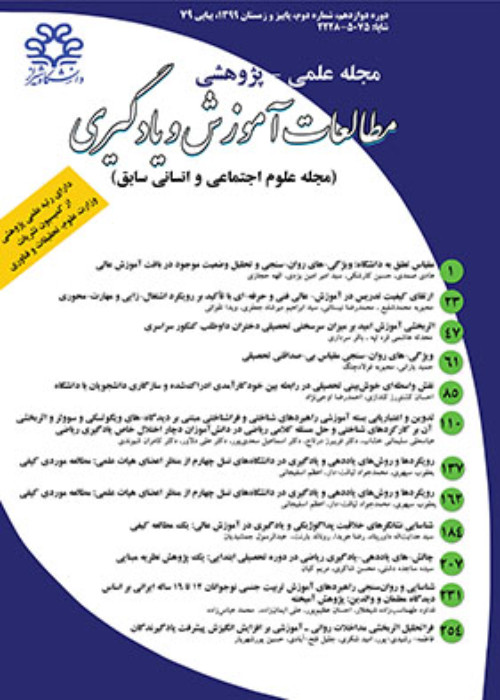Explanation of Students' Academic Boredom based on Perceived Learning Environment: Mediation Role of Task Value
Author(s):
Article Type:
Research/Original Article (دارای رتبه معتبر)
Abstract:
Introduction
Boredom is one of the achievement related emotions which is frequently experienced by students in academic contexts (Daschmann, Goetz & Stupnisky, 2011; Nett, Goetz & Hall, 2011) and may concern achievement activities, such as class attendance, study, and task or homework completion (Pekrun et al, 2004). It is a negative and deactivating emotion (Vogel-Walcutt, Fiorella, Carper & Schatz, 2012), involving an unpleasant feeling (affective), low-arousal (physiological), a desire to leave the boring situation (motivational), and a perception of slowness in time (cognitive) (Pekrun, 2006). Socialcognitive theorists assume that boredom negatively affect motivation, activating cognitive resources, self-regulation and achievement outcomes (Pekrun, Goetz, Daniels, and Stupnisky, Perry, 2010). Empirical evidence has revealed that this achievement emotion has detrimental effects on the students’ engagement in class and on their learning (Mann and Robinson, 2009; Tze, Klassen & Daniels, 2014), and is associated with Low academic performance (Pekrun and etal, 2010), school dropout (Wegner, Flisher, Chikobvu, Lombard, & King, 2008) and adolescence delinquency (Newberry & Duncan, 2001). Considering negative effects of boredom, educational scholars are studying and identifying antecedents of academic boredom (Daniels, Tze, and Goetz, 2015). Overall, researchers have pointed to three different categories of causes of boredom, including environment, person, and person-environment fit (Nett, Goetz & Daniels, 2010; Goetz and Hall, 2014). According to Robinson (1975), learning environment is an immediate and important environmental element for the student's academic boredom. Numerous studies have focused on the role of different aspects of the learning environment in determining the boredom experiences of learners (see Pekrun, Goetz, Titz, and Perry, 2002; Bartsch & Cobern, 2003; Fallis & Optotow, 2003; Glaser-Zikuda & Fub, 2008). Furthermore, the subjective value of academic activities has been known as a main personal cause of boredom (Pekrun and etal, 2010). Subjective value is a cognitive appraisal, which includes perceiving the importance of achievement-related tasks, activities and outcomes. Social cognitive theorists hold that cognitive appraisals have a mediational role in the relationship between environmental factors and achievement emotions. On such a basis and using a causal model, this study was aimed to investigate the role of learning environment elements and subjective value dimensions in determining the students' academic boredom.
Methods
A correlational research design was used to test the research hypotheses. Participants were 718 high school students (380 females and 338 males) who were selected from Shiraz high schools via multi stage cluster sampling method. The data was collected, administering three questionnaires including What Is Happening In this Class? (WIHIC), Task Value scale, and Learning and class-related Boredom Scales. The proposed Model was tested using structural equation modeling in AMOS software.
Results
The results showed that task orientation as a dimension of perceived learning environment could directly and positively predict attainment, and the intrinsic and utility dimensions of task value. Teacher support and involvement, as the other dimensions of the learning environment were positive predictors of the intrinsic and utility dimensions of task value. Student cohesiveness positively predicted attainment value and negatively predicted intrinsic value. Moreover, utility was found to have a direct positive effect on attainment value. Examining the indirect effects revealed that intrinsic value can mediate the relationship of student cohesiveness, task orientation, investigation, and teacher support as the elements of the learning environment with academic boredom. The proposed model's fitness to observations was desirable.
Discussion and Conclusion
The present study showed that some environmental factors can explain academic boredom with the mediating role of interest value. This entails a confirmation for the assumptions of Pekrun's theory on achievement emotions (2006). On the other hand, adopting a multidimensional approach to value construct as the most important cognitive factor associated with boredom, lead to a new and different finding that revealed new angles for the knowledge of academic boredom. Such a new approach can be considered in the process of reducing the student's boredom. Additionally, the simultaneous examination of several environmental factors led to the clarification of the most influential components of classroom. That is, the role of task orientation, teacher support and research as the most important inhibitors of academic boredom can be considered, in terms of planning and taking action to increase interest value and reduce academic boredom. Particularly, the obvious contribution of the teacher in these three factors is clear and promising. Therefore, it is suggested for the teachers to set up their class schedules based on task orientation and research elements of the learning environment if they want to improve the beliefs of task value and reduce academic boredom in their students. It is also recommended that teachers support students and more effectively meet their individual needs. The negative role of student cohesiveness in decreasing the amount of interest value and increasing academic boredom clarifies the both the positive and negative effects of peers. So, in order to prevent academic boredom and improve the attainment of schooling values, it is recommended for the educational planners and practitioners to form classrooms with a standard number of members. In this way, factors affecting the students' inattention and uninterest are reduced and as a result, their interest in the lesson is not damaged and they don't get bored. In addition, teachers through student grouping can get benefit from student cohesiveness in meeting class goals and in enhancing the different aspects of value of schooling. It should be noted that these findings are limited to the students of the tenth and eleventh grades of Science and Mathematics. Therefore, generalization of the findings to other situations and other students must be made with caution. Accordingly, it is recommended that other researchers examine the hypothesized model of this study with other groups of students.Keywords:
Language:
Persian
Published:
Studies in Learning & Instruction, Volume:10 Issue: 2, 2019
Pages:
1 to 32
magiran.com/p1951463
دانلود و مطالعه متن این مقاله با یکی از روشهای زیر امکان پذیر است:
اشتراک شخصی
با عضویت و پرداخت آنلاین حق اشتراک یکساله به مبلغ 1,390,000ريال میتوانید 70 عنوان مطلب دانلود کنید!
اشتراک سازمانی
به کتابخانه دانشگاه یا محل کار خود پیشنهاد کنید تا اشتراک سازمانی این پایگاه را برای دسترسی نامحدود همه کاربران به متن مطالب تهیه نمایند!
توجه!
- حق عضویت دریافتی صرف حمایت از نشریات عضو و نگهداری، تکمیل و توسعه مگیران میشود.
- پرداخت حق اشتراک و دانلود مقالات اجازه بازنشر آن در سایر رسانههای چاپی و دیجیتال را به کاربر نمیدهد.
In order to view content subscription is required
Personal subscription
Subscribe magiran.com for 70 € euros via PayPal and download 70 articles during a year.
Organization subscription
Please contact us to subscribe your university or library for unlimited access!



